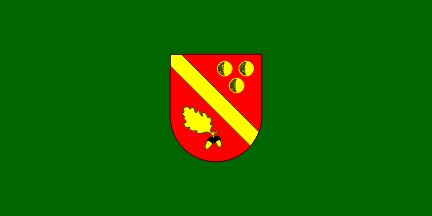
by Željko Heimer, 26 April 2005

Last modified: 2005-05-28 by dov gutterman
Keywords: virovitica | podravina | viroviticko-podrvska | mikleus |
Links: FOTW homepage |
search |
disclaimer and copyright |
write us |
mirrors

by Željko Heimer, 26 April 2005
See also:
Other Sites:
Mikleuš is a community in the Virovitica and Podravina
County some 40 km southeast of Virovitica
along the main road towards Osijek. Population just over 2,000
with half of the number in the village of the same name.
The coat of arms is shown on the County web site at <www.viroviticko-podravska-zupanija.hr>
possibly adopted in mid-1990's. The coat of arms of
Mikleuš is Gules a bend between three balls and an oak twig
all or. The three balls (oranges, apples?) are no dbout
attributes of St. Nicolas, the namesake of the community and
probably its patron, too. The flag is green with the coat of arms
in the middle. This was reported by Tomislav Sipek.
Željko Heimer, 18 November 2004
The three balls are not fruits but purses. St. Nicolas was
Bishop of Myra in the IVth century. The city of Myra, located in
Asia Minor, was the capital city of Lycia under Eastern Emperor
Theodosius II (408-450), declined in the VIIth century and was
abandoned in the XIIth century. At the end of the XIth century,
merchants from Bari (Italy) stole St. Nicolas' relics in Myra and
brought them to Bari, whose patron saint is St. Nicolas. A
tradition says that when the merchant opened Nicolas'
tomb, they were choked with a holy, strong perfume, so that they
picked up the wrong relics. St.Nicolas' tomb is today kept in the
neighbouring village of Demre. There are several legends related
to St. Nicolas. It is well-known that he resurrected three
children killed by a butcher who kept them into his
salting-tub. Another tradition reports that Nicolas helped a poor
who could not provide his three daughter with a dowry: the saint
placed three big purses filled with gold on the windowsill of the
poor's house. Accordingly, St. Nicolas is the patron saint of the
pawnbrokers, and is often represented with three round purses.
Ivan Sache, 25 December 2004
In the tradition over here, the three things are considered
apples or even oranges. The story of the dowry is also known
well, however the icons show the saint usually by carying three
round fruits.
Željko Heimer, 26 December 2004
British anthropologists have just reconstructed the face of St
Nicholas, based upon the bones which are ascribed to him in his
reliquary. There was an article about him in several British
newspapers, together with a photograph of him based on the
reconstruction, and also a tv show about the reconstruction. The
anthropologists added a gray beard to the features, as this would
among men of his age and status at that particular time and
place. St Nick comes out as not the kind of man you would want to
get into an argument with - a tough figure with a broken nose who
stood slightly over five feet tall; in other words, a typical
Levantine merchant who would have been among the wealthiest men
in his small town of Myra.
Ron Lahav, 27 December 2004
The flag shown in the County Assembly Hall differs slightly
from what I reported before: it is dark green with the coat of
arms in the middle (somewhat smaller then I reported).
Željko Heimer, 26 April 2005
vt-mi.gif)
by Željko Heimer, 18 November 2004